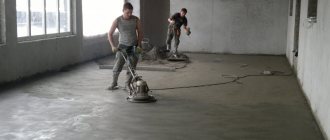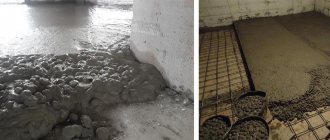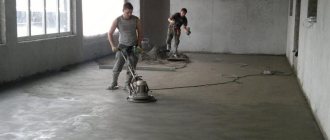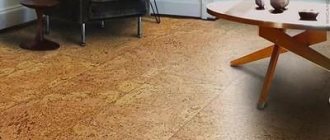Concrete screed is used as a rough base for various finishing floor coverings and can be used as the main floor in technical production rooms, garages, warehouses and other premises. To increase strength, it is reinforced with metal mesh or construction reinforcement of a periodic profile. In some cases, water protection is used. The specific features of the concrete screed depend on the operating conditions and purpose of the structure. Regardless of the specifics of the technology for pouring surfaces with concrete, all work consists of several stages.
Concrete screed
Installation of concrete floor screed
What are they needed for?
In order to install a modern coating efficiently, you must first level the surface with your own hands. After all, reinforced concrete slabs, which often serve as the base of the floor and are installed on the ceiling, have too many irregularities and differences . Moreover, for their manufacture, some manufacturers use concrete with high-frequency filler, which also does not contribute to the smoothness of the floor. It is the screed that helps to remove such flaws, which can be:
- semi-dry;
- wet;
- dry.
The main goal when leveling the base for the finishing coating is to create a smooth and reliable surface. Beacons installed strictly according to the level will help achieve this. For the master, such guide rails act as a guide, facilitating the process of screeding the floor.
Variety of compositions - choosing the best brands
Regardless of the manufacturer, when choosing a mixture, be sure to pay attention to several indicators.
- Best before date . Formulations in which it expires are often sold at discounts, but you should not skimp on quality. If the shelf life is coming to an end, there is a high probability that during storage the material was exposed to low temperatures and changes in humidity, which means it has lost most of its beneficial qualities.
- Price . The price of a well-known brand product is too low - a sure sign that this is a fake. Today's building materials market is replete with them.
- Material color . If it has a pronounced yellowish tint, this is a sign of poor quality due to excess sand or clay in the composition.
To ensure that your floors are poured quickly and efficiently, and serve for a long time and reliably, purchase materials from trusted manufacturers who have proven themselves well in the construction market. Such manufacturers rightfully include the German chemical concern Henkel, in whose laboratories the famous Ceresite was developed. This is a material that works great in any conditions. Buyers are amazed by the huge selection of Ceresit dry building mixtures - universal and high-strength, with a high setting speed and for screeds up to 80 mm thick.
Knauf dry floor screed system
Another German, and another brand of mixtures of the highest quality. “Knauf” is famous for its gypsum-based materials; self-leveling floors made from such a solution are distinguished by excellent strength and an ideal surface; you can read more about them here. Cement mortars from this manufacturer are no less popular; screeds made from them have noise-absorbing and thermal insulation properties. The Russian-German project “Bergauf”, domestic “Ivsil”, “Bolars” and “Osnovit” are worthy of attention, easy to use, and of high quality.
Types of lighthouses
Before moving on to leveling the base, you need to decide which guide strips . Benchmark and rack beacons are used for screeding. Moreover, slats of the latter type are metal, steel, wood, and also made of mortar, however, this method is used very rarely.
Wooden beacons for floor screed
These guide strips are usually made from timber. To adjust their level, screws are screwed under the slats or special wedges are placed. The disadvantages of wooden beacons include the fact that the wood, after some time, begins to lose its shape and rot. As a result, you have to remove them urgently, removing them from the screed.
Rack beacons made of steel pipes
When surface leveling needs to be done in a large room, it is better to use steel products, as they are highly durable.
Metal guide bars
Such beacons are in great demand, especially if repairs are being made in a small room. But you should take into account the fact that these slats are suitable for screeds not exceeding 30 mm . With a greater thickness of the leveling layer, they will simply bend.
But benchmark beacons are installed only when it is planned to create a self-leveling floor in the room. They belong to professional equipment that is used only by experienced builders. You won’t be able to use these guides for floor screeding yourself without certain skills.
Installation of pin elements
This work is not difficult to do with your own hands. To do this you need:
- drill a hole opposite the front door, stepping back from the corner 25 - 30 cm on each side;
- Insert the dowel into the hole and screw in the self-tapping screw so that the head is at the top level of the fill;
- Pull the fishing line onto the screws so that it matches the level of the mixture being poured;
- drill a series of holes on the floor under the fishing line at intervals of 1 - 1.5 m;
- Place self-tapping screws with dowels in the holes and align them along the fishing line;
- place elements on the surface.
Preparing the base before screeding
First of all, you will have to remove the flooring, baseboards and old screed, for the dismantling of which it is advisable to use an electric jackhammer. This tool is more powerful, and it will get the job done faster. A hammer drill is also suitable for breaking screeds. Then you need to remove all garbage.
It is best to level the floor for each room separately, and mask possible differences with door thresholds .
Preparatory work
Before you learn how to fill the beacon screed with your own hands, you need to learn about the preparatory work.
The screed must be laid on a solid foundation, so it is prepared first of all. If there is an old screed, then the best solution is to completely dismantle it using a powerful hammer drill. If the screed is laid on concrete slabs, then all cracks and holes should be covered with cement mortar. Regular tile adhesive is best suited for such purposes, as it has good adhesion to most surfaces and will provide waterproofing. As a result, after the preparatory work you should get a durable surface, free of dirt and dust. Depending on the connection with the base, the screeds are:
- Bonded ties – firmly connected to the base. Their thickness at the thinnest point should not be less than 3 cm.
- In rooms where there are increased requirements for waterproofing the base, so-called screeds are installed on the separating layer.
- When installing thermal insulation and heated floors, floating screeds are used, their minimum thickness is 5 cm; in addition, such screeds use wire mesh reinforcement.
Depending on the type of screed, appropriate preparation of the base is carried out.
The next stage is marking the floor
For proper placement of beacons and other work during screeding, the surface should be marked. The first step is to draw a horizontal line using a water level or level. The latter is easier to work with, although the accuracy of these devices is almost the same.
Marks are made on the surfaces of the walls of the room at the same height, between which a smooth horizontal line is drawn with a red thread, since it is easiest to move along the base until the desired result is obtained. Then you need to determine the low and high points on the floor. To do this, they usually use a tape measure to find out the distance from the line to the coating .
Using these methodical steps, you will be able to measure the entire floor surface and find out at what height to screed. It is advisable to make a mark on the walls so as not to get confused while working. But it’s better to watch a video on how to properly mark in a typical room.
Process requirements
When carrying out such work, certain rules must be observed: there should be no drafts in the room, the room should not be exposed to temperature changes, the reinforcing mesh must be installed correctly, rough chips and cracks must be eliminated in the rough base. Before work, the surface is cleaned of debris and dust. The latter should be removed with a damp cloth.
The screed should not be made too thick, otherwise it will negatively affect the load-bearing walls. Therefore, it is recommended to make a simple project, which will indicate the thickness of the floor, the amount of material used, etc. When constructing multi-story buildings from scratch, the following sequence of work must be followed:
- water pipes are laid out, plumbing fixtures are installed;
- Reinforced concrete slabs are cleaned of debris and dirt;
- the zero level of the base is calculated and measured;
- the subfloor is treated with a primer and dried.
If a dacha is being built from scratch, the surface of the earth is leveled, watered and compacted. A 15 cm layer of crushed stone and sand, the layer of which is 10 cm, is laid on the ground. Each laid layer is spilled with water and compacted. Then specialists make markings and find the zero level. Then the surface is covered with waterproofing and a metal frame is built for subsequent pouring.
After the operational life of the concrete screed has expired, it is necessary to begin its restoration. The floor covering is removed, the concrete is inspected, large cracks and other defects are identified. The cracks must be opened and filled with concrete. After repairs, the base should be filled with a self-leveling screed.
A do-it-yourself floating concrete screed involves applying a built-up roofing material to the rough coating. Then a metal mesh is installed. A novice concrete worker will be faced with the need to seal pipe outlets from under the floor. On concrete around protruding communications, you need to coat the gaps with sealant or mastic. Damper tape is glued along the perimeter of the walls. Thermal insulators are installed at the request of the home owner. If the floor has a thermal insulation layer, then a primer is first applied to the coating, polyethylene film is laid and insulation is laid.
How to place beacons correctly?
Then you need to draw lines on the floor surface that will serve as a guide when setting the guide rails under the screed. In this case, you should adhere to some rules:
- The screed should be leveled using a special rule. To make it more convenient to work, it is better to use a tool no more than 1.5 meters long.
- The gap between the beacon lines should be 20 cm less than the length of the metal strip.
- The distance from the guide lines to the walls should be 5-10 cm so that the rule reaches the surface and rests on the strips of the two lines.
- The screed should always be done in the direction from the far walls to the exit door.
- To level the floor, it is recommended to use metal beacons with a height of at least 10 mm.
Installing guide strips in leveling the floor with your own hands is the most important step, so it must be taken seriously. To fix the beacons, it is necessary to make small tubercles on the surface of the base from a cement screed mixture . Then they are sunk in the solution and leveled.
Main components for the solution
Main components for the solution
Classic concrete mortar contains cement, sand and water, taken in certain proportions. If the thickness of the screed is more than 4 cm, crushed stone is additionally used. To reduce the weight of the screed, special fillers with a porous structure are added to the solution - vermiculite, perlite and expanded clay. These components have high water absorption, and therefore when mixing the solution, water is added in a minimal amount - only to make the mixture plastic and convenient for application. In order for the screed to be of high quality and withstand the expected loads, the ratio of sand, cement and porous fillers must be observed very accurately.
Approximate ratio for ordinary concrete
The strength of a concrete base depends not only on the brand of cement, but also on its mass fraction in the solution. A simple table will help you choose the right ratio of components for the screed.
| Brand of Portland cement | Design grade of concrete | Mass composition of dry concrete mixture, Cement / Sand / Crushed stone | Average volumetric composition of dry concrete mixture, Cement / Sand / Crushed stone | Volume of concrete produced from 10 liters of cement |
| 400 | 100 | 1/4, 6/7, 0 | 10/41/61 | 78 |
| 500 | 100 | 1/5, 8/8, 1 | 10/53/71 | 90 |
| 400 | 150 | 1/3, 5/5, 7 | 10/32/50 | 64 |
| 500 | 150 | 1/4, 5/6, 6 | 10/40/58 | 73 |
| 400 | 200 | 1/2, 8/4, 8 | 10/25/42 | 54 |
| 500 | 200 | 1/3, 5/5, 6 | 10/32/49 | 62 |
| 400 | 250 | 1/2, 1/3, 9 | 10/19/34 | 43 |
| 500 | 250 | 1/2, 6/4, 5 | 10/24/39 | 50 |
| 400 | 300 | 1/1, 9/3, 7 | 10/17/32 | 41 |
| 500 | 300 | 1/2, 4/4, 3 | 10/22/37 | 47 |
| 400 | 400 | 1/1, 2/2, 7 | 10/11/24 | 31 |
| 500 | 400 | 1/1, 6/3, 2 | 10/14/28 | 36 |
You cannot use old-caked cement to prepare the solution: even if the proportions are observed, such a screed will very soon crack or begin to crumble. When preparing for repairs, buy cement last, making sure to check its expiration date. The sand is pre-sifted, because excess impurities and debris also reduce the density of concrete. For the same reason, water for the mixture is taken not from a reservoir, but from tap water or spring water.
DIY concrete
Filling the screed along the beacons
To create a leveling layer, as a rule, a cement-sand mortar or a dry mixture is used. Moreover, the latter option is more preferable, since it contains polymer components that improve the properties of the composition, however, the cost of such a screed is noticeably higher.
It is best to purchase washed sand for such work, since clay can weaken the quality of the screed. To make the leveling layer strong enough and able to withstand heavy loads, 1 part of sand should be used, and 3 parts of cement. If the requirements for the base are not so strict, then the proportion of bulk material can be slightly increased.
When preparing the screed mixture, it is recommended to use plasticizers to reduce the proportion of water, increase the properties of the solution and make it mobile. In addition, such compositions dry out much faster.
If the screed is made under a warm floor, in addition to the plasticizer, it is necessary to add fiber fiber to the solution: basalt or polypropylene. With it, the leveling layer will be able to withstand strong temperature changes.
To perform the screed you will need the following tool:
- Trowel, spatula, grater and construction rule to level the leveling layer.
- Construction mixer or concrete mixer. In these devices you can prepare a high-quality solution. If there is no such equipment, then you can knead the mixture manually with a shovel in a special container.
- Dental spatula to create a contact layer used in bonded screeds.
- Wheelbarrow for transporting mortar to the place of work.
When mixing the mixture by hand, you need to mix the dry ingredients in the required proportions in any deep trough; it is advisable to immediately add fiberglass to it. But it is better to dissolve the plasticizer in water. Then liquid is poured into the solution at the rate of no more than 15 liters per 50 kg of cement mixture . Everything is mixed well with a shovel. If the solution is made using a mechanized method, its quality is much better.
Then the finished screed mixture must be transferred to the work site. You should start pouring from the far corner of the room, moving towards the doorway. Pour the solution between the guide rails. First, one strip is created between the lines of beacons, and then they move to another.
When the entire mixture has been poured out, it must be distributed evenly. For such purposes, use a shovel or trowel, and the level of the screed should be slightly higher than the beacon.
Then, using the sharp edge of the rule, holding the tool perpendicular to the guide bars, starting from the farthest point, the mixture is pulled towards itself. To make it easier to move, swing it to the right and then to the left. If it doesn’t work, watch the video to see how to do it correctly. Excess mixture is removed, and its deficiency is compensated with a trowel , placing the required amount into the recesses. After these procedures, the floor becomes smooth without holes and bumps. The screed continues to be done on all strips between the slats, completing the work at the door.
Dry mixes - quick and convenient
Fortunately, materials have appeared on the market that make the job much easier. These are dry construction mixtures for pouring floors. All the necessary components in the required proportions are in one package. To get started, just mix the dry mixture with the amount of water specified in the instructions. Today, manufacturers produce mixtures used for finishing or starting pouring of concrete floors based on two different materials: cement and gypsum.
Types of materials for pouring floors
Cement mixtures include, in addition to cement, synthetic and mineral fillers, plasticizers. Their purpose depends on the type of fillers and the size of the fractions:
- coarse sand, crushed stone and granite chips - for rough screed;
- fine-grained fillers from 0.6 mm and plasticizers - for finishing screed;
- fillers with a size of about 0.5 mm, modifiers and fiber fiber are part of the self-leveling mixture for the finishing screed.
A gypsum-based floor screed mixture is used only indoors; it makes an ideal finishing coating. It consists of gypsum, fine sand and polymer fibers, which give it plasticity and the finished floor covering additional strength. Traditionally used for flooring in residential premises, since gypsum is considered an environmentally friendly material.
The finishing coating, made from a construction gypsum mixture intended for finishing floor screed, acts as a natural insulation, as it has low thermal conductivity. Being a natural self-regulating material, it releases moisture if the air in the room is dry, and in case of high humidity it absorbs excess liquid. If you use a ready-made gypsum mixture as a base for a wooden floor, it will never crack from dryness or warp from excess moisture.
Elimination of irregularities
You can walk on the leveled floor surface the very next day, but you should not place sharp objects on the screed, and it is advisable to wear shoes with flat soles. Experts advise placing plywood or a piece of board under your knees to distribute the load.
When arranging the screed along the beacons, you cannot avoid the appearance of small irregularities, which can be removed the next day. For example, holes can be easily filled with tile adhesive, and sagging can be removed with a spatula or rule .
The top leveling layer, approximately 3 mm thick, is a stratified mixture of cement, water and sand. That is why it should be wiped down so that it does not collect dust later. To do this, run a wooden float over the entire surface of the screed.
Floor unevenness is allowed no more than 2 mm. After pouring the leveling layer, you need to moisten the surface with water for several weeks to prevent it from cracking. It is best to apply it over the base with a damp roller.
The sand and cement screed will dry completely in a month. To reduce this period, do not forget to use plasticizers . Many modern surface leveling solutions allow you to lay the topcoat a week after pouring.
Properties of crushed stone
The choice of the appropriate type of crushed stone is made based on its composition:
- Granite. A popular material, it has high strength, frost resistance and a minimum of additives.
- Limestone. Also a common option. In terms of strength, it is not inferior to granite and, in addition, is resistant to temperature changes. The composition contains impurities.
- Dolomite. Hard and frost-resistant material with a rough surface. Excellent adhesion to cement mortar.
- Slag. It is formed as a result of processing waste slag, a by-product of metallurgical facilities.
The quality of crushed stone is affected by its ability to withstand moisture and frost. The more moisture it absorbs, the greater its mass becomes and the durability decreases. Frost affects it in a similar way.











